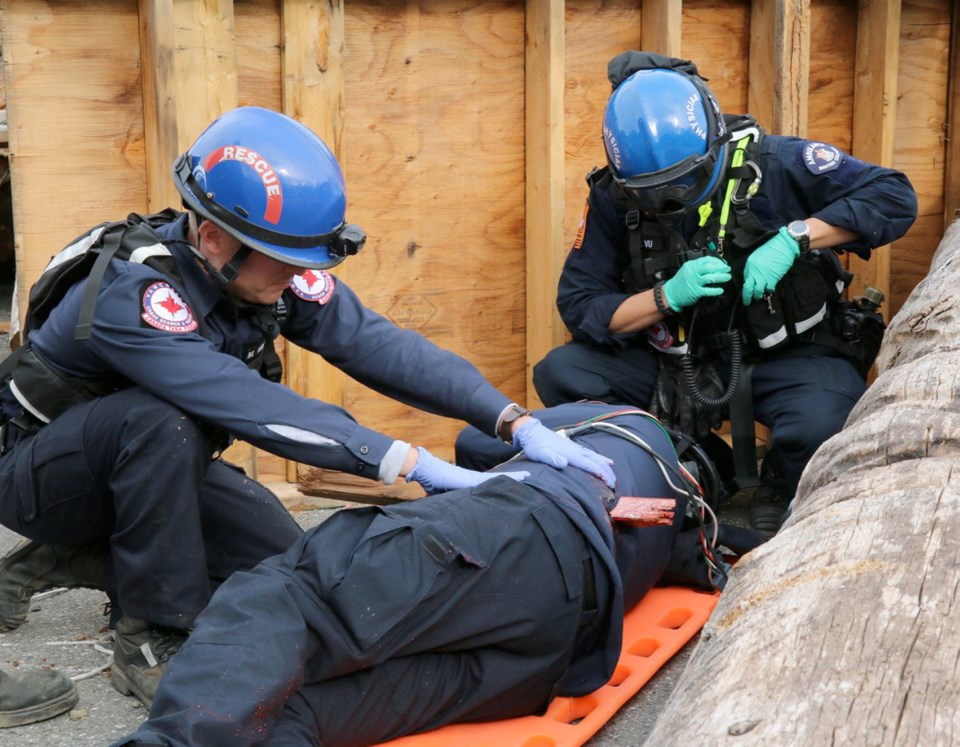 The report card on the earthquake/tsunami exercise in Port Alberni last summer was released Tuesday.
The report card on the earthquake/tsunami exercise in Port Alberni last summer was released Tuesday.
Good news — everybody passed.
Officials seem loath to dwell on any breakdowns or screwups that might develop during these kinds of drills, preferring to consider learning experiences and opportunities for improvement.
So the independent evaluation of B.C.’s biggest emergency scenario stresses that the feedback collected from hundreds of participants is “not a record of shortcomings.”
It’s considered a summary of areas where further work, or more money, or more staff, is needed.
The findings are based on the $1.2-million Exercise Coastal Response that imagined an early-morning 9.0 earthquake off the coast of southwestern B.C. Strong shaking lasting several minutes was simulated in Greater Vancouver, Greater Victoria and central Vancouver Island, causing some destruction in the major urban centres and widespread damage in the Alberni Valley.
The earthquake would also generate a tsunami on the west coast of Vancouver Island minutes after the initial shock. A thousand people marshalled in the Alberni Valley to deal with the imagined aftermath over the course of four days, which included massive casualties, property damage and thousands of displaced tourists. It’s designed partly to produce failures, and to learn from them.
One of the dominant findings was how vital communications are, and how difficult it is to organize a response when communications start failing. Widespread communication failures were built into the exercise, and one note remarked on how difficult it was to gather situational awareness and pass on critical instructions.
At the more mundane level, “during periods of Internet outages, printers would not function without network connectivity.” The lesson learned in that case was that redundant technologies should be considered as part of an IT renewal project. That project got a priority boost from another observer, who noted one team was working with computers that were 20 years old.
Also on communications, a lack of consistency was noted in guidelines for co-ordinating radio usage, which led to gaps. One agency was able to connect with Royal Jubilee Hospital via amateur radio and with another agency via commercial radio, but couldn’t reach other health providers via radio or satellite phone. Another agency said there were significant shortcomings with satellite phones and phone lists.
Even communication by simple speech needs to be worked on. One note said operational briefings became drawn-out when conversations became specific to a particular person or issue. “Briefings and meetings must be brief, concise and relevant to all participants.”
Another finding was that exhaustion needs to be factored in. Significant fatigue was reported over the four non-stop days. “In order to remain effective over time, staff should detach from their tasks and take short breaks (when possible).”
All evaluators said the high level of intense activity was draining on everyone. “If this were a real disaster response … staff fatigue and high stress levels would diminish productivity and problem resolution.”
All those observations will go into refining B.C.’s one-year-old Immediate Response Plan and all the lower-level plans that flow from it.
The general findings were that the test of the Immediate Response Plan was a success. Collaboration was effective and the lessons were learned together, before the real thing.
The initial report on Coastal Response was presented at a seminar at the Union of B.C. Municipalities convention attended by about two dozen delegates on Tuesday. They were told that the various agencies that need to step up in a catastrophe need more staff, the plans need to be refined further and a lot of technology needs to be upgraded.
As well, the drill must be repeated again, to provide ongoing training.
Just So You Know: Every agency involved came with its own list of acronyms, to the point where the planning reports look like alphabet soup. VIR PREOC, EMBC, EMBC/PSC/LO, PENS, PERRC, etc. One agency said tasks were delayed due to “staff interrupting others to try to define meanings of acronyms, or merely guessing.”



